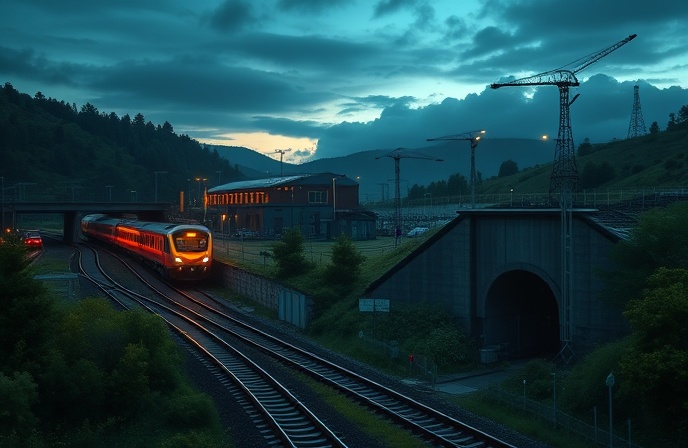UK Rail Evolution: HS2, Digital Railway & Infrastructure Future
UK railway modernization, including HS2 and network upgrades, is transforming the transport infrastructure for a more resilient future.

UK Transport Infrastructure: Navigating the Path to a Resilient Railway Network
The UK railway network, a vital artery of the nation’s economy and a cornerstone of the UK transport infrastructure, is currently undergoing significant transformation. From ambitious high-speed rail projects to vital upgrades across the existing infrastructure, the rail industry faces a complex landscape of challenges and opportunities. This article delves into the key aspects of this evolution, examining the projects shaping the future of rail travel across the UK. The primary focus is to examine ongoing initiatives and their potential impact on the long-term health and efficiency of the UK railway. We’ll explore modernization efforts, technical advancements, and the strategic planning involved in maintaining a world-class railway system that is fit for the 21st century.
Modernization of the Existing Network: Enhancing Capacity and Reliability
A crucial element of bolstering the UK transport infrastructure involves the modernization and upgrade of the existing railway network. This encompasses everything from track renewal and signaling system upgrades to station enhancements and rolling stock improvements. Network Rail, the primary infrastructure manager, is spearheading many of these initiatives. One key area of focus is the deployment of European Train Control System (ETCS) signaling, designed to improve safety, increase line capacity, and ultimately, enhance the operational efficiency across the network. The program includes comprehensive track maintenance, power supply upgrades, and the implementation of digital railway technologies. Such upgrades improve the network’s ability to handle increasing passenger and freight volumes, contributing to a more reliable and sustainable transport ecosystem. This approach contrasts with building entirely new lines like High Speed 2 (HS2) that add to the overall national investment in the UK transport infrastructure.
High-Speed Rail: Transforming Connectivity and Economic Growth
The High Speed 2 (HS2) project, despite recent adjustments, remains a pivotal aspect of the UK transport infrastructure strategy. Once completed, the high-speed line will significantly enhance connectivity between major cities, particularly between London, Birmingham, and, in its later stages, potentially extending north. HS2 is more than just a railway line; it’s a catalyst for economic growth, regional development, and a significant improvement in journey times. The project necessitates innovation in various areas, including track laying, tunneling techniques, and train design. The new infrastructure will integrate seamlessly with the existing network, providing connections to other key destinations. It is however, a large investment and has generated debate about the appropriate use of resources in the modernization of the overall UK transport infrastructure.
Digital Railway and Data-Driven Optimization
The integration of digital technologies is a fundamental driver in the evolution of the UK transport infrastructure. Data analytics, automation, and advanced signaling systems are revolutionizing the way the railway operates. This includes predictive maintenance, where sensors and data analysis identify potential issues before they lead to service disruptions. The Digital Railway program aims to create a more efficient, reliable, and resilient network through technologies like Automatic Train Operation (ATO) and advanced traffic management systems. By leveraging real-time data, operators can optimize train movements, reduce delays, and improve the overall passenger experience. This technology-driven approach is vital for maximizing the capacity and efficiency of existing infrastructure, creating a more sustainable network. The adoption of digital solutions will also require significant training and investment in personnel.
Sustainability and Environmental Considerations
The future of UK transport infrastructure must prioritize sustainability and environmental responsibility. Reducing carbon emissions and minimizing the environmental impact of railway operations are critical goals. This includes the increased electrification of the network, the use of renewable energy sources, and the development of lighter, more energy-efficient trains. Furthermore, railway infrastructure projects must incorporate environmental impact assessments and adhere to strict environmental regulations. The shift towards sustainable practices not only benefits the environment but also enhances the long-term viability of the railway network, attracting investment and supporting a green economy. Furthermore, the adoption of quieter track technologies reduces noise pollution for communities near railway lines.
Conclusion
The evolution of UK transport infrastructure represents a crucial period of investment and innovation for the rail industry. From the modernization of existing lines to ambitious projects like HS2 and embracing digital technologies, the railway is poised to play a critical role in the UK’s future. The industry faces the challenge of balancing investment, sustainability, and efficiency. However, with continued focus on the key areas identified above, including modernization, digitalization and environmental responsibility, the UK railway can move forward as a vital and reliable mode of transport. The industry is on the cusp of a transformation that will change transport for generations. As the sector navigates challenges and embraces opportunities, the long-term impacts of these initiatives will be felt across the nation, shaping economic growth, and improving quality of life. The continual investment in the UK transport infrastructure ensures that the railway remains a world-class transportation system.



